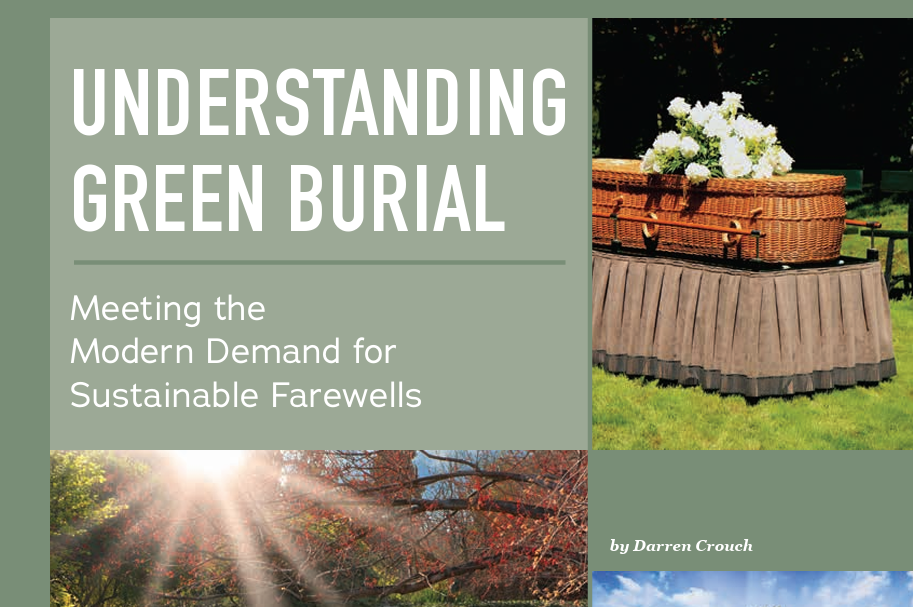(404) 312-6640
UNDERSTANDING GREEN BURIAL
As consumer preferences shift toward sustainability, the funeral industry faces an evolving demand: green burial. No longer an afterthought, green burial is gaining traction among families who seek meaningful, environmentally responsible ways to honor their loved ones. Funeral homes that understand and embrace this trend have a unique opportunity, not only to meet these shifting values but to grow their business while protecting the planet.
WHAT IS GREEN BURIAL?
Green burial, sometimes referred to as natural burial, is a method of caring for the deceased with minimal environmental impact. It prioritizes conservation of natural resources, reduction of carbon emissions, and restoration or preservation of habitat. In contrast to conventional burial where the focus is preservation of the body, green burials avoid embalming chemicals, metal caskets, and concrete vaults. Instead, bodies are often buried in biodegradable caskets or shrouds and laid to rest in natural or conservation-focused environments. The goal is to return the body to the earth in a way that supports ecological renewal, not preserve the body. The Green Burial Council (GBC) sets standards for this practice and offers certification for funeral homes, cemeteries, and products that meet their environmentally responsible criteria. These include the absence of plastics and toxic f inishes, the use of biodegradable materials, and minimizing the carbon footprint associated with transportation.
DEMAND FOR GREEN BURIAL:WHAT THE DATA SHOWS
Research consistently shows that green funerals are not just a passing trend, they are increasingly expected by consumers:
• According to the NFDA 2024 Consumer Preferences & Awareness Study, 60% of Americans are interested in green funeral services.
• More than 84% would consider a green burial if it were offered to them.
• Over 85% of those who would plan a green funeral say they would still contact a funeral home to help them plan it.
• Nearly one-third of families who choose burial now say they prefer green burial over traditional interment.
What this tells us is clear: the demand exists, and it’s growing. Importantly, families who want green funerals still rely on professionals for guidance, planning, and meaningful services.
WHY FUNERAL HOMES SHOULD OFFER GREEN BURIAL BEFORE FAMILIES ASK
For many funeral homes, the problem isn’t a lack of demand, it’s a lack of proactive offering. If families don’t see environmentally friendly options in the selection room, they may assume it isn’t offered at all. Many modern families no longer resonate with traditional services. If the only options presented to them are conventional casketed burial or basic direct cremation, they may choose the latter by default, not because it’s what they want, but because it feels like the only viable alternative. This leads to lower engagement, less revenue, and diminished satisfaction. However, when funeral homes introduce meaningful green options up front, families are not only more willing to invest, they also feel more seen and supported in their values.
THE SHADES OF GREEN: THREE TYPES OF GREEN BURIAL
The Green Burial Council defines three key types, or “shades,” of green burial, offering families a spectrum of ecological choices:
1. HYBRID BURIAL
A hybrid burial takes place in a conventional cemetery that allows for some green practices. This might mean permitting biodegradable caskets or shrouds, skipping vaults, and reducing or eliminating embalming. However, the cemetery itself may still maintain traditional lawn care or include conventional grave markers. Hybrid burial is often the most accessible form for families, especially in areas where dedicated green cemeteries aren’t available.
2. NATURAL BURIAL
Natural burial takes place in cemeteries that actively avoid modern funeral practices. These cemeteries forgo pesticides, herbicides, and mechanical landscaping, favoring native vegetation and minimal disturbance to the land. No vaults, metal caskets, or embalmed bodies are allowed. Grave markers, if permitted, are typically natural or locally sourced. This approach allows for a deeper ecological return of the body to the earth and fosters a sacred, serene atmosphere.
3. CONSERVATION BURIAL
The most rigorous of the three, conservation burial occurs in cemeteries that are part of a larger conservation effort. These grounds often partner with land trusts and include long-term conservation easements. Conservation burial sites integrate comprehensive ecological impact assessments and aim to preserve biodiversity and habitat. This form offers families a dual legacy, one that honors the individual and contributes to environmental protection on a larger scale.
WHO CHOOSES GREEN BURIAL?
The green burial customer is often someone who has lived with environmental intention, such as recycling, reducing consumption, and making everyday choices that reflect care for the planet. For these individuals, it only makes sense to extend those values into the final chapter of life. They believe that death, like life, shouldn’t contribute to pollution or unnecessary waste. Importantly, the desire for green options transcends faiths, cultures, and backgrounds. This growing and diverse interest makes it essential for funeral providers to meet these families without assumptions, offering flexible, inclusive options that align with their personal and ecological values.
ENVIRONMENTAL CONCERNS AND FUNERAL INDUSTRY IMPACT
Conventional burial has a substantial environmental footprint. According to the Green Burial Council: • Over 115 million tons of casket steel have been buried in U.S. cemeteries.
• Burial vaults have used more than 2.3 billion tons of concrete.
• Toxic embalming chemicals pose risks to both workers and ecosystems.
Green burial doesn’t just reduce environmental burdens, it also supports broader social and ethical values. Many eco-friendly burial products, like those offered by Passages, are Fair Trade certified, meaning they are handcrafted under safe working conditions, with fair wages and sustainable practices. These biodegradable products are made from renewable materials like bamboo, which grows rapidly without the need for deforestation or toxic processing. It’s a meaningful choice that reflects both environmental responsibility and social impact.
LEAD THE WAY, DON’T WAIT
As the demand for green burial grows, funeral homes face a critical choice: lead or lag. Families today are already exploring these options. Some know exactly what they want. Others are looking for guidance. In either case, it’s up to professionals to present green choices proactively, not as a niche add-on, but as a core offering. Whether it’s through hybrid burial options in an existing cemetery, partnerships with natural burial grounds, or stocking certified biodegradable and Fair Trade products, the steps are available now. And with resources like the Green Burial Council and providers like Passages International, funeral homes don’t have to figure it out alone. Green burial is not just about ecology, it’s about empathy, values, experience, and legacy.

Darren is President and CEO of Passages International which he co-founded in 1999. Passages provides sustainable and ecofriendly solutions for funeral professionals and healing, meaningful experiences for families. Crouch holds a BSc. (Hons) degree from Manchester Metropolitan University in Manchester, England, and is the current President of the Green Burial C






Comments